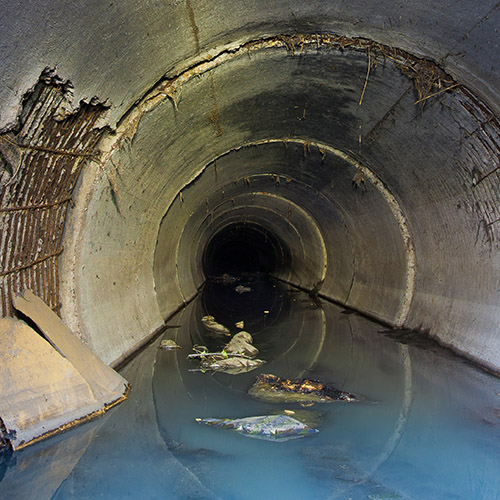 Water treatment sludge could be used to prevent 117,000 kilometres of sewer pipes in Australia from cracking in future, without any intervention by humans, helping to save $1.4 billion in annual maintenance costs.
Water treatment sludge could be used to prevent 117,000 kilometres of sewer pipes in Australia from cracking in future, without any intervention by humans, helping to save $1.4 billion in annual maintenance costs.
A world-first project led by University of South Australia sustainable engineering expert Professor Yan Zhuge is trialling a novel solution to halt unprecedented levels of corrosion in the country's ageing concrete pipelines.
Corrosive acid from sulphur-oxidising bacteria in wastewater, along with excessive loads, internal pressure and temperature fluctuations are cracking pipes and reducing their life span, costing hundreds of millions of dollars to repair every year across Australia.
Self-healing concrete, in the form of microcapsules filled with water treatment sludge, could be the answer.
"Sludge waste shows promise to mitigate microbial corrosion in concrete sewer pipes because it works as a healing agent to resist acid corrosion and heal the cracks," Prof Zhuge says.
Researchers will develop microcapsules with a pH-sensitive shell and a healing agent core containing alum sludge - a by-product of wastewater treatment plants - and calcium hydroxide powder. The combination will be highly resistant to microbially induced corrosion (MIC).
It will be embedded inside the concrete at the final step of mixing to protect it from breakage. When the pH value changes as acid levels build up, microcapsules will release the healing agents.
"This technology will not only extend the lifetime of concrete structures, saving the Australian economy more than $1 billion, but it will promote a circular economy as well by reusing sludge that would normally end up in landfill," Prof Zhuge says.
Existing repairs of deteriorating concrete not only cost millions, but they are often short-lived, with 20 per cent failing after five years and 55 per cent failing after 10 years.
Existing methods to contain acid corrosion in sewer pipes are unsuccessful for a variety of reasons.
Chemicals can be added to wastewater to alter the sewer environment and stop corrosion, but they contaminate the environment and are also costly. Another option involves increasing the speed of sewage flow by amending the pipe hydraulics, but this is not always effective. Surface coating is another popular option, but it is time consuming, and the effect is temporary.
"Improving the concrete mixture design is the preferred method for controlling microbially induced corrosion. Using self-healing concrete that can seal cracks by itself without any human intervention is the solution."
To be carbon-neutral by 2050, the construction industry is being forced to transit to a circular economy, Prof Zhuge says.
"Industry by-products or municipal wastes that would normally be discarded in landfill sites, potentially generating pollution, may now be reused in the construction production chain.
"Mainland Australia alone has about 400 drinking water treatment plants, with a single site annually generating up to 2000 tonnes of treated water sludge. Most of that is disposed of in landfill, costing more than $6 million each year, as well as causing severe environmental issues."
Disposing one tonne of sludge in landfill releases approximately 29.4 tonnes of carbon dioxide emissions - much higher than cement production - and leaches aluminium into the soil and water, a risk factor for Alzheimer's disease.
"We are confident this novel self-healing concrete based on advance composite technology will address issues of sewer pipe corrosion and sludge disposal in one hit," Prof Zhuge says.
The project is being partially funded by a $501,504 Australian Research Council grant and involves researchers from the University of South Australia and University of Queensland.
Notes for editors
Yan Zhuge is a Professor in Structural Engineering at UniSA STEM and a renowned expert in sustainable concrete material. Over the past five years she has attracted more than $4 million worth of grants, published 149 journal papers and in 2018 won the South Australian Innovation Award in Engineering for her research on using waste in concrete.






